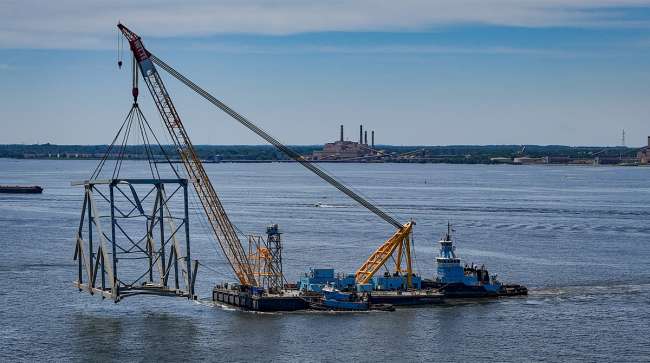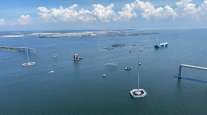Baltimore Sun
Full Port of Baltimore Channel Set to Open by June 10

[Stay on top of transportation news: Get TTNews in your inbox.]
Crews in the Patapsco River are still cutting and lifting large chunks of what remains of the Francis Scott Key Bridge as they clear the way to restore the full 700-foot-wide channel into the Port of Baltimore.
While larger vessels have recently been able to transit cargo into and out of the port through a limited-access channel, heavier lifts are needed to restore traffic back to normal.
The Army Corps of Engineers now expects to have the full Federal Channel open by June 10 at the latest, a slightly later target than their original timeline of late May.
Millions of pounds of steel and concrete from the bridge were still sitting in the river at the end of May. The later estimate — based on surveys completed after crews moved the Dali, the freighter that hit the Key Bridge on March 26 — accounts for the “complexity of the cutting and rigging,” ensuring safety measures are in place and the possibility of inclement weather, the Army Corps said.
Here’s what needs to happen before the full channel reopens.
Some Heavy Lifting
The largest roadblock for salvage crews is the 10 million-pound span of the Key Bridge that had pinned down the Dali for 55 days.
Only about a third of what remains of “Section 4,” the large pieces of steel truss that collapsed on top of the ship and remain in the water, is visible above the water line, said Cynthia Mitchell, a spokesperson for the Army Corps of Engineers’ Baltimore District.
Salvage crews on June 1 completed the lift of a 470-short-ton (940,000 pounds) steel section of #FSKBridge truss from the federal navigation channel. 🏗 Buried deep in the river mudline, the section was part of the massive steel truss that pinned the M/V DALI for seven weeks. pic.twitter.com/MeSrMpMFWJ — USACE Baltimore (@USACEBaltimore) June 3, 2024
Crews are getting that section of truss out by cutting it into three pieces to be pulled out using the massive Chesapeake 1000 crane. The first piece, a 140-ton section of steel, was lifted out May 24. Crews were cutting off the second piece from the third and final section May 31.
The weather, which has previously muddied salvage plans, is expected to cooperate for only a little while. After a mostly sunny weekend, the National Weather Service is forecasting a 30% chance of showers and thunderstorms in Dundalk on June 3. The next day is expected to be partly sunny, but chances of showers and thunderstorms are expected at night all the way through June 7.
Picking up Remaining Scraps
Once those three large sections are out of the way, crews will still have to pull excess steel and roadbed out of the water, including wreckage below the mud line, according to Mitchell.
🏰 The current specs of the Unified Command's "limited access channel" (50-foot depth x 400-foot width) allow all shipping traffic to enter/exit the @portofbalt, and these final lifts are an important next step to re-opening the full 700-foot width of the navigation channel. pic.twitter.com/RBHTmeNO4f — USACE Baltimore (@USACEBaltimore) June 3, 2024
In addition to what broke up and fell into the Patapsco River on March 26, several smaller pieces of steel also were flung into the water when crews used explosives to break apart the piece of truss lying on top of the Dali’s bow.
“Gus,” a massive hydraulic salvage grab that arrived in Baltimore in April to help with salvage operations, excels at scooping up debris.
The Dutch-made set of four claws is built to hold up to 1,000 metric tons, according to its manufacturer, The Grab Specialist. When the claws came to Baltimore from Galveston, Texas, in late April, a spokesperson for Key Bridge Response Unified Command said they were expected to be a “vital part” of subsurface debris removal operations.
The claws were notably used during salvage operations for the Golden Ray, a roll-on/roll-off cargo ship that capsized near Georgia in 2019 while on its way to the Port of Baltimore. The 200-ton hydraulic grab was able to pick up 20 vehicles at a time.
Mechanical dredge buckets also are being used to conduct “obstruction removal” in the wreckage area, Mitchell said. The dredging is needed to pick up an estimated total of 60,000 to 70,000 cubic yards of displaced material — sediment and debris — from the federal channel, she said. Debris will go to a solid waste facility, and the remaining material will be mixed with cement and taken by dump trucks to disposal sites in New Jersey and Pennsylvania.
Final Checks
Before reopening the full channel, crews will conduct final surveys to ensure there’s no more problematic debris.
Unified Command crews have been conducting dive surveys combined with sonar imagery throughout their response to assess the mangled wreckage, some of which has sunk below the mud line.
Teams will have to conduct more surveys to “identify any remaining wreckage hot spots and ensure no steel is left behind” before the full channel is reopened, Mitchell said.
Will the Port Be Ready?
As crews continue to clear debris from the channel, the Biden-Harris Administration Supply Chain Disruption Task Force has been preparing for the Port of Baltimore to return to full operations.
The task force — established in 2021 to monitor and address supply chain challenges — met numerous times following the collapse of the bridge to coordinate the administration’s response to the closure of the port and its impact on the supply chain.
In a National Economic Council meeting May 30, agencies worked to proactively identify any pre-existing logistical or operational challenges shippers, businesses and ocean carriers might be facing before the port’s reopening.
Want more news? Listen to today's daily briefing above or go here for more info
Officials from the departments of agriculture and transportation discussed coordination efforts with port operators and food producers as shipping routes and schedules shift back to Baltimore. As shipping activity increases, transportation officials, truckers and port operators have been in collaboration to ensure that the port, along with the surrounding Baltimore area, are ready for increased traffic, according to a news release from the White House.
The meeting follows Gov. Wes Moore’s meeting with President Joe Biden in late May to discuss progress in fully reopening the federal channel after the Dali was moved back to port.
Biden has underscored his commitment to assisting Baltimore in its recovery and clearing of the channel. With the recent clearing of debris, the first containership since the collapse is expected to arrive during the first week of June.
Distributed by Tribune Content Agency, LLC



